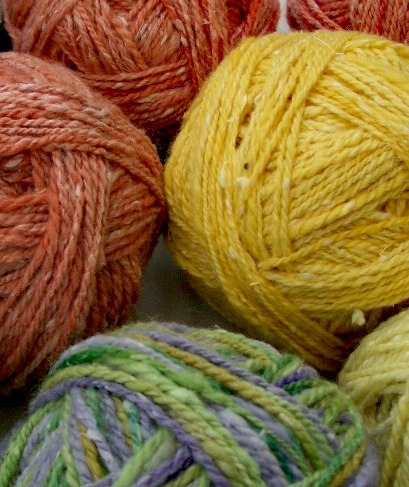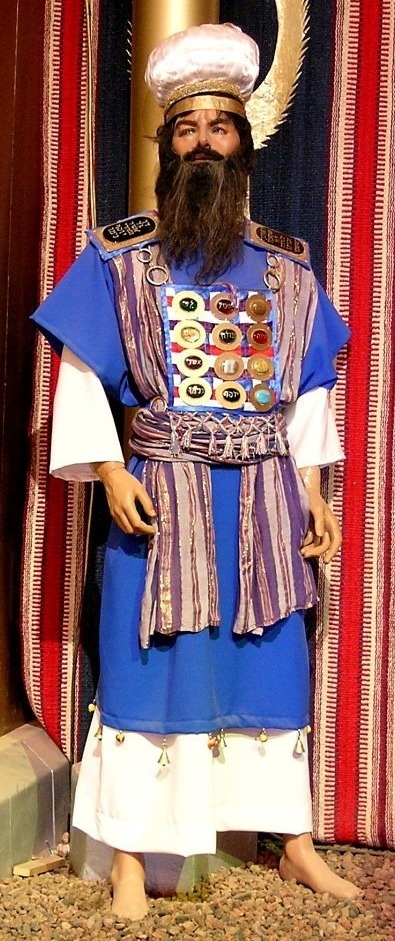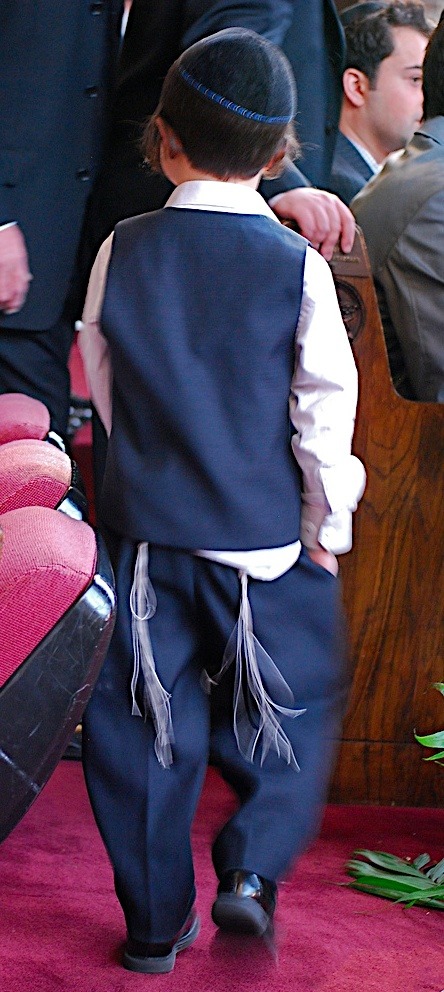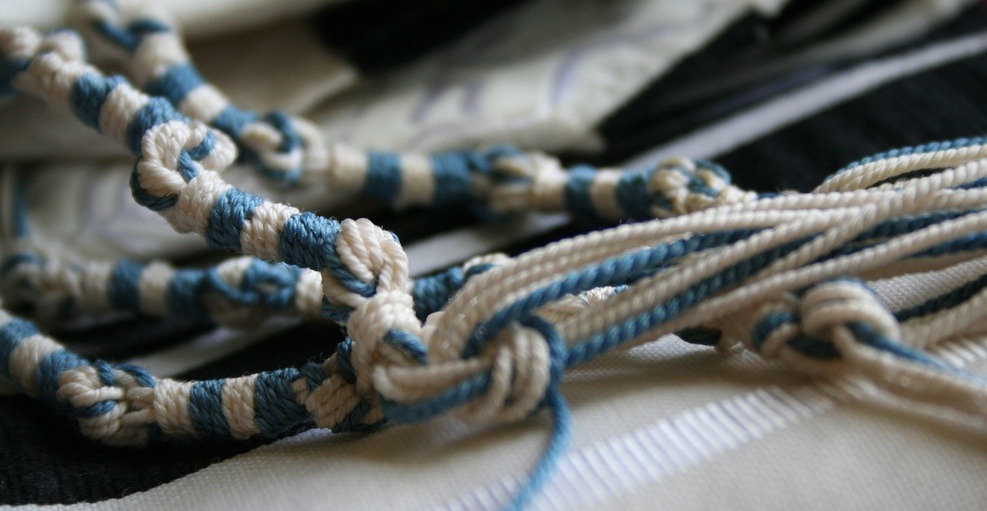 Most Christians would agree — the levitical law that wins the prize for weird is Deuteronomy 22:11:
Most Christians would agree — the levitical law that wins the prize for weird is Deuteronomy 22:11:
“Do not wear clothes of wool and linen woven together.”
Why on earth did God make such an odd prohibition? I used to roll my eyes at this one.
In its ancient context, though, the law had a perfectly logical reasoning. Both the priestly garments and the tabernacle weavings were a combination of wool and linen. The priest’s white undergarment was linen, and the brightly colored vestment was wool. So it was prohibited for laypersons to dress in the same way.
Other prohibited mixtures had the same rationale. For instance, no one but the priests could blend together aromatic spices to make the combination used in anointing oil (Exodus 30:33). The distinctive fragrance would mark whatever it anointed as holy, set apart for God’s special purposes.
 Why? Because the Israelites were fresh from a polytheistic world and still half-convinced that pagan gods would answer their prayers. They were strongly tempted to set up their own private D-I-Y shrine to offer a few sacrifices on the side. So they were barred from duplicating certain items used in worship.
Why? Because the Israelites were fresh from a polytheistic world and still half-convinced that pagan gods would answer their prayers. They were strongly tempted to set up their own private D-I-Y shrine to offer a few sacrifices on the side. So they were barred from duplicating certain items used in worship.
We actually have similar laws today. Did you realize that it’s illegal to dress up in a badge and a uniform to impersonate a police officer? The police are authorized to stop a car, break down a door, or handcuff a person — things no one else may do. In the same way, God had given priests the authority to lead worship in his Holy Presence, and they had to be noticeably different from everyone else.
The Tension of the Tzitzit
It may surprise you, then, that the tassels that the Israelites were commanded to wear violate the command against wool and linen mixtures. God told Israel to put tassels (tzitzit – “ZEET-zeet”) on the corners of their garments in Numbers 15:38. One of the strands was dyed with tekhelet, the blue dye that was used in the high priest’s robe and the tabernacle covering. Wearing tassels was a sign of nobility, and the blue dye suggested priestly status. Jacob Milgrom, the eminent Jewish scholar notes:
In antiquity, the tzitzit (and the hem) was the insignia of authority, high breeding and nobility. By adding the blue woolen cord to the tzitzit, the Torah combined nobility with priesthood: Israel is not to rule man but to serve God. Furthermore, tzitzit is not restricted to Israel’s leaders, be they kings, rabbis or scholars. It is the uniform of all Israel. (1)
 Milgrom also points out that in the first century, tassels were actually made from a wool-linen mixture, even though that violated the code against mixing the two fibers. In The JPS Torah Commentary on Numbers, he explains that this was quite deliberate:
Milgrom also points out that in the first century, tassels were actually made from a wool-linen mixture, even though that violated the code against mixing the two fibers. In The JPS Torah Commentary on Numbers, he explains that this was quite deliberate:
“What is there about the tzitzit that would remind its wearer of holiness? The earliest rabbinic sources, perhaps dating back to biblical days, taught that the tzitzit are sha‘atnez, a mixture of wool and linen. In fact white linen cords and dyed woolen cords were found in the Bar Kockba caves, proving that the rabbinic teaching was actually observed. Sha‘atnez is forbidden because it is a holy mixture, reserved exclusively for priests and forbidden to nonpriests. …Thus the tzitzit, according to the rabbis, are modeled after a priestly garment that is taboo for the rest of Israel!” (2)
The reason that Israelites wore wool and linen together in the tzitzit was because they realized its message. God’s goal was that they would be a “nation of priests” — representing the true God in how he wanted the world to live. Every person was to have this mark of priesthood. In their tassels, they were all priests, even if they were prohibited from imitating them otherwise.
Resonating with Korah
If you think about it, there’s a tension here. Everyone is supposed to be a priest, and yet some were set apart from all the rest. That doesn’t seem very fair. In fact, when Korah led a rebellion against Moses, being a “nation of priests” was what he based his argument on. Numbers 16:3 says,
“You have gone too far! The whole community is holy, every one of them, and the LORD is with them. Why then do you set yourselves above the LORD’s assembly?”
They had taken their tassels seriously and realized that they were ALL priests. And to them, being priestly meant that no one could give them orders, since they all had the same status in God’s eyes. How dare Moses take charge! (3)
As I read Korah’s words, I have to admit that at first glance, he sounds like he has a good point. Aren’t we all equal God’s sight? Aren’t we all special in his eyes? Equality is fundamental to the way we see the world today. How dare anyone tell us they are in authority! Korah sounds like he lives in modern America – he has the spirit of this age.
We can hardly imagine that God would disagree with our love of democracy. And yet, God set up a system where people had to live with the tension that every person was to see himself as representative for God, yet must yield to the authority of a priestly leadership.
Hmmm… how can we learn from the tension God put in place about being between priestly and non-priestly? You’re welcome to share your thoughts below.
~~~~~
(1) More about the commandment to put tassels on one’s garments in the chapter, “Touching the Rabbi’s Fringe” in my book, Sitting at the Feet of Rabbi Jesus, p 145-161. (The quote is from p 150).
(2) From the JPS Torah Commentary on Numbers by Jacob Milgrom, New York: Jewish Publication Society, p 203. The laws against mixing wool and linen are still observed by Orthodox Jews today. The blue dye became so expensive after the first century that it was not required. Nowadays, tzitzit are not made of wool-linen mixtures either.
(3) One interesting rabbinic tale was that Korah’s wife was particularly insulted that the tzitzit only included one blue woolen strand. She accused Moses of lying when he gave the commandment, because she was sure that God said that the tzitzit should be all blue, not just a little bit!
(Images from bibleplaces.com, rachelpasch, and Angerboy)
~~~~~
You may also be interested in reading…
Letting Our Tassels Show
How to Hallow the Name of God
Learning from Jesus’ Jewish Prayer Life

marge willman says
Thank you for clearing up one of the “eye-rollers” of all time. The prohibition of wearing wool and linen together makes sense after your explanation.
Nathan Joshua says
Thanks and God bless you for clarifying Deuteronomy 22:11 so well. May you also clarify Deuteronomy 22:9 and 10: 9 You shall not sow your vineyard with a second kind of seed, or the whole yield will have to be forfeited, both the crop that you have sown and the yield of the vineyard itself. 10 You shall not plow with an ox and a donkey yoked together. Thanks again.
Lisa Guinther says
If I may answer Nathan; the differing seeds may be a response against Canaanite magical ritual of “marrying” the seeds to bring forth a larger harvest.
As to the ox/donkey, that may be related to more magic or flat common sense: oxen are stronger than a donkey. But in the context of that passage, it most probably relates to a polemic against ancient Near East magical practices.
Hope that helps.
Nathan Joshua says
Thanks and God bless you Lisa for your insightful response.
Lois Tverberg says
Nathan –
My understanding is that these two laws had two different reasons. The ox/donkey law is to be humane to animals, because the weaker animal would suffer in the pairing. Other laws are similar, like not muzzling an ox as it threshes, and not capturing both a bird and her young at the same time. From these laws they derived an overriding principle, which was “Tzar Ba’alei Hayim,” which forbids causing “suffering to living beings.” That’s the reason why the Sabbath can be set aside to pull an ox out of a well.
As far as why mixed fields were prohibited, I’ve never read about a Canaanite “marrying” ritual. In Hebrew, it says that the produce of the field would become “sanctified,” which is why it had to be forfeited. It was regarded as a priestly mixture, just as a wool-linen blend was.
One thing to point out – subsistence farmers actually do use this technique, because plants actually do grow better in mixed fields because they aren’t all competing for the same nutrients. Also, in drought-prone areas, if one crop fails another may still yield. Often people read the Torah looking for God’s secrets for prosperity, not realizing that its concern was holiness, not necessarily wealth.
Kat says
I was just talking with one of my orthodox clients about this rule a few weeks ago! She didn’t know the history, but this explanation makes a lot of sense. Thanks for the fascinating post, Auntie. 🙂
Lois Tverberg says
Fun! You’ll have to introduce us when I come out to visit. 🙂
Margaret Bosanquet says
Good job Lois
brent emery says
There is a very interesting connection with the tzitzit of Numbers 15 and the “spy narrative” that precedes it in Numbers 13 and 14. In Numbers 13:2 the Hebrew word for “spy” is Tur. The same Hebrew word is used again in Numbers 13:25 and 14:34. In Numbers 14:33 Israel is told they would wander the wilderness because of faithlessness/harloty which is the Hebrew word “zenut”. In Numbers 15:39 the text reads, “And it shall be a tassel for you to look at and remember all the commandments of the Lord, to do them, not to follow (Hebrew-Tur) after your own eyes, which you are inclined to whore (Hebrew-zanah). The reason we have the tzitzit is so that we will not forget the commandments which the generation coming out of Egypt did. The command to wear tzitzit is tied by key words to the previous narrative where the children of Israel failed to be obedient. G-d gave them/us the tzitzit to remind us of our need to be obedient.
Lois Tverberg says
Brent, that’s true. The “tzitzit” are a kind of string-around-your-finger to remind a person that as part of God’s priesthood, they are on display to the rest of the world. They can’t blend in.
Clinton Nauert says
We are followers of the Master and obedient to the King/God — Yeshua gave us his example of our place within the priesthood (an example from the living Word).
John 5:30 “I can of mine own self do nothing; as I hear, I judge; and my judgment is just; because I seek not mine own will, but the will of the Father which hath “sent” me.” John 13:16 “Verily, verily, I say unto you, The servant is not greater than his lord; neither he that is “sent” greater than he that “sent” him.”
If Yeshua could not overrule the Commandments then neither can we overrule anything biblical — but only obey.
ginette says
actually i think it refers to the mixing of wool and linen during the weaving process not that you can’t wear an item of clothing made from linen + another item of clothing made from wool, anyway hardly applicable in this day and age as much of our clothing is made from synthetic fabrics, and as basically all they knew were clothes made from wool linen and possibly cotton and of course the luxury of silk, i think we will be forgiven if we were to ask God how deuteronomy would fit in our world today.
i can just see how stoning would go down in modern society, and how many women would accept the ruling they were worth less than a tenth of the value of a man. JESUS broke with all traditions as it was to a woman he first showed his RESURRECTED SELF on easter day (sunday) and He never denigrated women but always respected them
Rena says
This was so interesting. I have wondered about that verse. Thank you.
Sandra King says
An ox and a donkey are not to be yoked because an ox is considered a clean animal while a donkey is an unclean animal. They would be unequally yoked as a believer and unbeliever would be unequally yoked in the NT. A donkey must be redeemed by a land or, if not, be put to death. Ex. 34:20
Wool comes from sheep and linen from flax. Linen represents righteousness. Wool gets dirty and smelly until it is purified (cleansed).
God doesn’t like mixed seed. A mule cannot reproduce. Only man can create a mule by mixing seed. God has no part in it!
Sandra King says
Correction: A donkey must be redeemed by a Lamb!
John Michael says
Could there be an idiom there with regard to the mixing of things that would then be a sin, ie adultery? The mixing of a married man and a woman through intercourse?.
Lois Tverberg says
No, that’s not a valid analogy. Once again, the mixture of wool and linen was specifically used in priestly garments and tassels. Adultery is wrong because it violates a sacred, covenantal relationship.
Lois Tverberg says
One more time – the law about mixing wool and linen is not about teaching that all mixing is wrong. It’s not about the idea that wool is sinful. Wool was the fabric used for the high priest’s outer vestment.
Certain animals were unclean to eat, but were regularly used for other purposes, like donkeys and camels. The reason it was wrong to yoke a donkey and ox together was because it was cruel, not just because it was a mixture.
A lot of ideas about the levitical laws are preacher’s conjectures that aren’t based on knowledge of the practices in the Ancient Near East or archaeology. My suggestion is to read Jacob Milgrom’s work on Leviticus and Numbers.